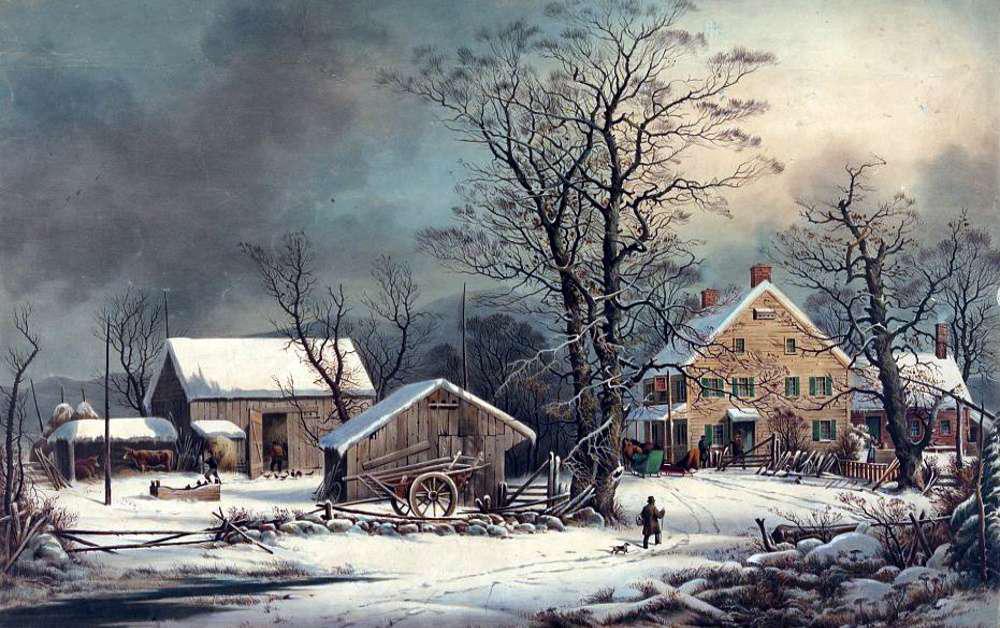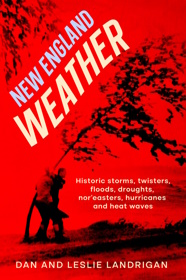This story about the January thaw is an excerpt from the New England Historical Society’s recent book, “New England Weather.”
Meteorologists will tell you the coldest cold in New England happens when high pressure in Canada pushes air from the North Pole into the region—the “Siberian Express.” It can drop temperatures well below zero for several nights and keep them below zero during the daytime.
But unlike other parts of the country, New England has intense cold snaps that don’t last long—usually a day or two. Another consolation during the bitter weeks of winter is the January thaw. It’s a climatic singularity—a climate event that occurs every year at about the same time. The January thaw happens nearly every January, usually between the 21st and the 25th. Temperatures will rise then throughout the region.
What Causes the January Thaw?
Many meteorologists believe a change in the pattern of winds in the upper atmosphere causes the January thaw. The high-pressure system over Bermuda strengthens, raising temperatures in New England. Then the polar high intensifies, bringing back winter.
The record for the coldest temperature ever recorded in New England was set in a place that creates its own nasty weather—the White Mountains. Their highest peak, Mount Washington, recorded a temperature of minus 50 on Jan. 22, 1885.

Mount Washington
The mountain, known as “home of the world’s worst weather,” has recorded temperatures as low as 8 degrees–in June. Its mean annual temperature is near 26 degrees. Mount Washington also averages 254 inches of snow every year.
For a while, Mount Washington owned the record for the highest wind speed in the world. On April 12, 1934, observers recorded a gust of 231 mph—and lived to tell about it.
No January Thaw Here
Northern Vermont is no slouch when it comes to cold weather, either. The tiny town of Bloomfield tied Mount Washington’s minus 50 record on Dec. 30, 1933.
Prohibition had ended that month, which may have stopped the smuggling of booze across the line from Canada, a little over 20 miles away. So, on that cold December day, Bloomfield residents could warm themselves with a shot of brandy—legally.

Winter in Vermont
Vermont can also claim a distinction for variability. The Lake Champlain region in northwestern Vermont has the greatest daily variation in temperature in the country.
Meanwhile, the town of Norfolk, Conn., has been called the “Icebox of Connecticut.” It recorded the coldest official temperature in the state on Feb. 16, 1943, at minus 37 degrees.
“A chilly spot,” is how a New York Times reporter characterized the town in a Feb. 14, 1988, story. “It is the place where the snow is said to be deeper, the temperatures lower and the winters longer than elsewhere in Connecticut.” Norfolk also gets the most snow in the state during an average year—107 inches.
Subzero temperatures happen rarely in Rhode Island—typically, one day a year or not at all along the coast. Most of the interior gets maybe five days a year of below-zero temperatures. But in cold winters, the southwest part of the state can get as many as eight below-zero days. In fact, the coldest temperature ever recorded in Little Rhody was minus 28 on Jan. 17, 1942, in Richmond, a few miles inland in southwest Rhode Island.
Brrrrr
As you might guess, a town in northern Maine matched Mount Washington and Bloomfield, Vt., for the coldest temperature ever recorded in New England.
The thermometer read minus 50 degrees on Jan. 16, 2009, in Clayton Lake, an unincorporated village in Aroostook County, Maine. That was two degrees colder than the coldest temperature ever recorded in the state. So cold, in fact, that it triggered two meetings of the state’s Records Verification Committee.
The committee brought together people from an alphabet soup of government agencies. They included the National Weather Service (NWS) in Caribou, the U.S. Geological Survey (USGS) in Augusta, the Maine state climatologist, the National Oceanic and Atmospheric Administration (NOAA), Northeast Regional Climate Center (NRCC) in Ithaca, N.Y., and the National Climatic Data Center in Asheville, N.C.

A New England backyard in winter
An instrument at Maine’s Big Black River station for the USGS had recorded the record low arctic temperature. The climatologists then challenged the reading and had several instruments tested. In the end, the Records Verification Committee unanimously voted to accept the minus-50-degree verdict.
That’s Variability
Chester, Mass., can arguably claim to have the most variable seasonal weather in New England. The small town on the eastern edge of the Berkshires spent an unusually cold Sunday watching the Los Angeles Raiders trounce the Washington Redskins in the 1984 Super Bowl. Los Angeles scored 38 points, Washington scored 9 and Chester scored a record minus 40 degrees.
Chester is also one of only three U.S. municipalities that recorded the hottest and coldest temperature in its state. On Aug. 2, 1975, known as New England’s Hot Saturday, the mercury rose to 107 degrees. That’s higher than the highest recorded temperatures in the Florida cities of Miami, Orlando and Tampa. Mount Washington also set its own record for high temperatures that day—70 degrees.
***
Click here to order your copy today.
Images: Vermont in winter: By Vermont – Own work, CC BY-SA 4.0, https://commons.wikimedia.org/w/index.php?curid=79902314. Backyard winter scene, By EgorovaSvetlana – Own work, CC BY-SA 4.0, https://commons.wikimedia.org/w/index.php?curid=143483562.


